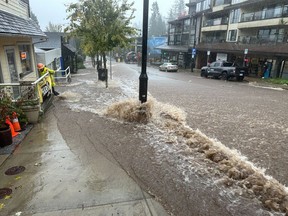Municipalities need to think about infrastructure capable of withstanding the bigger swings in rain brought by climate change

Article content
The atmospheric-river deluge that dumped a month’s worth of rain onto Metro Vancouver over the weekend is a reminder that municipalities need to build infrastructure capable of handling the bigger swings in rainfall caused by climate change.
Part of the problem is that municipal engineers use historical data and averages to estimate how much rain they will need to accommodate, according to civil engineer Troy Vassos, an adjunct professor in the University of B.C.’s engineering school.
Advertisement 2
Article content
However, the rain that Metro Vancouver has received over the past couple of decades “has been dramatically varied” than it was historically.
“We don’t have a consistent climate pattern any longer, for whatever reason.”
“If you’re all designing everything for 50 millimetres a day of rainfall, and give it a factor of safety of two, 100 millimetres, and then suddenly we’re getting 150 millimetres events or 170 millimetres events, you can see that very quickly you can exceed the standard design parameters,” Vassos said.

During last weekend, the storm delivered 203 millimetres of rain to West Vancouver from Friday to Sunday evening, Coquitlam got 256 millimetres with 85 millimetres of that falling over a six-hour period of Saturday morning, said Ken Dosanjh, a meteorologist with Environment and Climate Change Canada.
“(Coquitlam was) seeing one-hour rates upwards of 20 millimetres an hour, which is pretty astronomical,” Dosanjh said.
In other locations, rainfall ranged from 113 millimetres at YVR to 175 millimetres in Vancouver Harbour, Dosanjh said. He added that normal rainfall at YVR is 120 millimetres for the entire month of October.
Crews in the District of North Vancouver did put in work preparing storm sewers and roads, according to Peter Cohen, director of the North Shore emergency operations centre.
However, “the volume of rain was unprecedented, and in some cases, more than storm systems could accommodate,” Cohen said in an emailed statement.
Social media channels showed numerous videos of North Shore creeks and streams bursting their banks and torrents of backed up storm water flowing down streets into Deep Cove.
Article content
Advertisement 3
Article content
The deluge also caused problems for Metro Vancouver’s sanitary sewer system, which experienced 21 overflows where rainwater infiltration into the system overwhelmed its pipes, according to Mani Deo, Metro’s deputy general manager.
He added that nine of those locations were still overflowing as of Monday morning.
“Some of that has to do with the fact that we’ve had several breaks in our collection system.”
Deo said Metro spent most of the week leading up to the storm drawing down all available storage in their system to make room, getting materials, sandbags and pumps ready. “From Friday night on, we’ve essentially been working around the clock dealing with it, including up to this morning.”
Deo said that storm water winds up in Metro’s sanitary sewers several ways.
Older sewer systems, such as in Vancouver and New Westminster, have what are called combined systems in which both household waste and storm drains flow into the sanitary sewer system, because “100 years ago, that was the way things were done,” Deo said.

Rain water also seeps in through cracks or leaks in pipe, or in cases where residents, inadvertently or otherwise, connect the drainage from downspouts into sanitary sewer lines, or pump water into them during storms.
Advertisement 4
Article content
Deo said Vancouver and New Westminster are putting money into untangling their combined systems over time, but generally “you can’t build your way out of these one-in-100-year events.”
“We have been working with our member municipalities on ways of getting the message out on just the impacts of inflow and infiltration,” Deo said. “And of making sure residents understand (the impact) of hooking your rain leaders into the sanitary system.”
In North Vancouver, on Monday, Cohen said crews were still focused on “triaging immediate life-safety” problems and repairs. The district, on Sunday, declared a state of local emergency and ordered the evacuation of six properties on Deep Cove’s Panorama Drive.
“Further assessments may be needed to determine whether any infrastructure changes are warranted,” Cohen said in his statement.
Recommended from Editorial
Bookmark our website and support our journalism: Don’t miss the news you need to know — add VancouverSun.com and TheProvince.com to your bookmarks and sign up for our newsletters here.
You can also support our journalism by becoming a digital subscriber: For just $14 a month, you can get unlimited access to The Vancouver Sun, The Province, National Post and 13 other Canadian news sites. Support us by subscribing today: The Vancouver Sun | The Province.
Article content




Comments